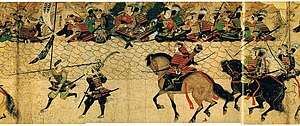Hakozaki Shrine
Hakozaki Shrine (筥崎宮, Hakozaki-gū) is a Shintō shrine in Fukuoka .[1]
| Hakozaki Shrine (筥崎宮, Hakozaki-gū) | |
|---|---|
 Hakozaki Shrine's rōmon | |
| Religion | |
| Affiliation | Shinto |
| Location | |
 Shown within Japan | |
| Geographic coordinates | 33°36′52″N 130°25′24″E |
History

Hakozaki Shrine was founded in 923, with the transfer of the spirit of the kami Hachiman from Daibu Hachiman Shrine in what is Honami Commandry, Chikuzen Province in Kyūshū.

During the first Mongol invasion on November 19, 1274 (Bun'ei 11, 20th day of the 10th month), the Japanese defenders were pushed back from the several landing sites.[3] In the ensuing skirmishes, the shrine was burned to the ground.[4] When the shrine was reconstructed, a calligraphy Tekikoku kōfuku (敵国降伏; surrender of the enemy nation) was put on the tower gate. The calligraphy was written by Emperor Daigo, dedicated by Emperor Daijo Kameyama as a supplication to Hachiman to defeat invaders.
The shrine is highly ranked among the many shrines in Japan. It was listed in Engishiki-jinmyōchō (延喜式神名帳) edited in 927. In 11th or 12th century, the shrine was ranked as Ichinomiya (一宮; first shrine) of Chikuzen Province.
Admiral Heihachiro Togo, famous for defeating Russia on the seas, was known to worship often at Hakozaki shrine.
From 1871-1946, Hakozaki was officially designated a Kanpei-taisha (官幣大社), in the first rank of government supported shrines. Other similar Hachiman shrines were Iwashimizu Hachimangū of Yawata in Kyoto Prefecture and Usa Shrine of Usa in Ōita Prefecture.[5]
Shinto belief
Hakozaki Shrine is dedicated to the veneration of the kami Hachiman.[6] This shrine especially venerates the memory of Emperor Ōjin, Empress Jingū and Tamayori-bime.[7]
Treasures
A number of structures in the shrine complex have been designated as important cultural assets of Japan, including the main hall, the worship hall, tower gate and the main Torii, Ichino-torii.[7]
Festivals
The annual Tamaseseri Festival (January 3) and the Hojoya Festival (September 12–18) attract many visitors to the shrine.[7]
See also
| Wikimedia Commons has media related to Hakozaki Shrine. |
Notes
- Ponsonby-Fane, Richard. (1962). Studies in Shinto and Shrines, p. 339.
- "Mongol Invasions of Japan". Archived from the original on 2003-04-06. Retrieved 2017-08-29.
- Davis, Paul K. (2001). 100 decisive battles: from ancient times to the present, p. 147.
- Turnbull, Stephen R. (2003). Genghis Khan & the Mongol Conquests 1190–1400, p. 66.
- Ponsonby-Fane, Richard Arthur Brabazon. (1959). The Imperial House of Japan, pp. 124-126.
- Ponsonby-Fane, Shrines, p. 195.
- Fukuoka/Hakata Tourist Information website: Hakozaki Shrine.
References
- Davis, Paul K. (1999). 100 Decisive Battles: From Ancient Times to the Present. Oxford: Oxford University Press. ISBN 978-0-19-514366-9; OCLC 0195143663
- Ponsonby-Fane, Richard Arthur Brabazon. (1962). Studies in Shinto and Shrines. Kyoto: Ponsonby Memorial Society. OCLC 399449
- Turnbull, Stephen R. (2003). Genghis Khan & the Mongol Conquests, 1190-1400. London: Taylor & Francis. ISBN 978-0-415-96862-1
External links
- (in Japanese) Hakozaki Shrine website
- (in Japanese) Fukuoka/Hakata Tourist Information website, Hakozaki Shrine, images + video